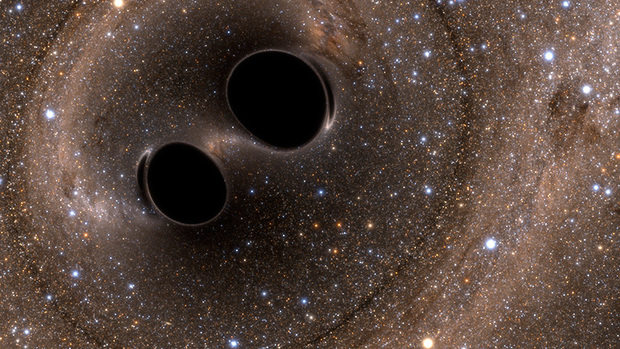For the last week I’ve been very excited about the detection of gravitational waves by LIGO, but haven’t written about it because I wanted to first learn more. Last night I attended the Cosmology SIG meeting (a sub-group of RCA, the Rose City Astronomers). I’ve wanted and planned to attend their meetings for years, but somehow never got around to it. It was very well worth it!
There are many interesting aspects to the story of this discovery. Probably the most important view is that this is the dawn of an entirely new age in astronomy. The moment that we first saw a gravitational wave is very much like Galileo’s first gaze at the night sky through a telescope; revealing for the very first time things that we had not seen before – things that would radically change our understanding of the universe.
For example, the event detected by LIGO (actually seen Sept. 14, 2015, but not announced until last week due to the need to analyze and confirm the observation) was the merging of two super-massive black holes. Despite the truly incredible amount of energy involved in this event (more on that later), we could not have seen it by any other method. It was widely believed that such events do happen, based on indirect evidence, but they do not show up in any of our various detectors covering a huge portion of the electromagnetic spectrum. And this is not the only type of event that has been hidden from our view. It is hoped that more sophisticated gravitational wave detectors will allow us to see several kinds of theorized events, and it is very reasonable to assume that we will see things that we did not expect.
The detection last September was seen by both of the LIGO detectors that were operational at the time. It is necessary to have at least 2 detectors to be sure that an observation is real (because both see the same thing at the same time [or, more precisely, at times separated by the speed of light between the 2 sites]), but just as having 2 ears allows us to tell roughly where a sound comes from, we can determine the approximate location of this black hole merger by analyzing the timing, amplitude, and frequency of the signals from these 2 sites.
But although the LIGO detectors are claimed to be the most sensitive measuring instruments ever made, having just 2 of them, each barely able to detect the waves resulting from incredibly powerful events, means that we really have a very primitive system when compared to what is possible. Several other detectors are being built at other locations on Earth, and the LISA Pathfinder mission is actively testing the possibilities of a very much larger detector based on placing multiple instruments in orbit around the Sun.
Having multiple detectors will allow much more precise location of objects/events, as well as more precise, noise-free definition. It is noteworthy that the event detected by LIGO was barely above the threshold of detection for LIGO. In fact, LIGO had been operating for about 10 years without detecting anything, until the system was upgraded last year to increase its sensitivity. It was shortly after this upgrade was complete that the detection happened and it was clear that it would not have been seen by the original system.
One thing about the LIGO observation that I particularly like is that the most direct way to experience the signal is through our ears rather than our eyes. It doesn’t sound very impressive, but actually gives a very clear idea of the signal detected. Listen for the “chirp” here: http://podcasts.nytimes.com/podcasts/2016/02/11/science/space/ligo-chirp/LIGOChirp.mp3. I’ve often thought that our sense of hearing is often overlooked as a tool for science. Our ears, and the associated processing of audio signals in the brain, are incredibly sensitive and sophisticated instruments. And at least for events like this black hole merger, the frequency of the gravitational waves falls well within the range that we can hear.
The black hole merger happened approximately 1.3 billion light-years from Earth and the amplitude of the signal diminishes by the square of the distance, which is why the signal was so weak. But that weakness belies the power of the original event. The super-massive black holes started out at approximately 36 and 29 solar masses. That is, one was 36 times the mass of our Sun, and the other 29 times the mass of our Sun. But the remaining single black hole after the merger was 62 solar masses, meaning that approximately 3 solar masses just disappeared in the process. A star like our Sun lives for about 10 billion years, constantly converting matter to energy through nuclear fusion. An incredibly small fraction of this energy reaches Earth and directly or indirectly provides virtually all of the energy we use. But when the Sun dies after 10 billion years, much of its mass will still be present, just not enough for it to maintain its stability as a star. So: All our energy is a very small fraction of what the Sun produces, which is a fraction of the potential energy based on E = MC², and continues to do so for billions of years. The black hole merger that LIGO observed converted 3 times the mass of the Sun into energy in a fraction of a second. Seriously, you would NOT want to be near (even in astronomical units) when that happened!
